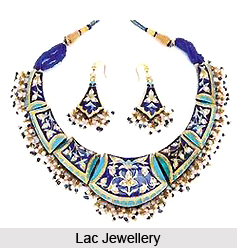 Lac Crafts of Northern India are one of the most cherished craftworks of the country. They have originated in India since time immemorial. Archaeological researches have provided evidences for the existence of this craft since 1600 BC. Lac, a resin produced by wild trees and accumulated by insects, finds utility in a range of products. But its utility in handicraft industries has been widely acknowledged since ancient times. Various alluring products are furnished by lac craftwork including jewellery, pen stands, ashtrays, mirrors, key chains, coasters, photo frames etc.
Lac Crafts of Northern India are one of the most cherished craftworks of the country. They have originated in India since time immemorial. Archaeological researches have provided evidences for the existence of this craft since 1600 BC. Lac, a resin produced by wild trees and accumulated by insects, finds utility in a range of products. But its utility in handicraft industries has been widely acknowledged since ancient times. Various alluring products are furnished by lac craftwork including jewellery, pen stands, ashtrays, mirrors, key chains, coasters, photo frames etc.
Lac Crafts of Indo-Gangetic Plain
Punjab is one of the prime centres of Lac Crafts in Northern India. Places like Amritsar and Jalandhar are renowned for this craftwork and cater the needs of people of the entire country. Lac crafts in Punjab have a traditional touch. Locally known as `abri craft`, lac craftwork of Punjab furnishes articles like furniture, decorative items, jewelleries, toys and many more. In northern India, Haryana is also well acclaimed for beautiful lac jewelleries of a variety of designs and shapes. Ornaments with lac craftwork are also a popular artefact of Uttar Pradesh. Bangles, bracelets, trinkets, beads etc made of lac in this region exhibit a unique style and elegance. Lalit, in Uttar Pradesh, is the place where lac crafts are mainly produced. Bihar is another important centre for attractive lac crafts. Both tribal and contemporary artisans are involved in this craftwork. Santhal, Mo, Munda, Bhumij and Oraon are the tribes of Bihar engaged in this activity. This craftwork is characterized by intricate designs, fine finish and vibrant colours. Combination of lac crafts with stone, ivory or mirror works adds to their charm. Sometimes beads or gemstones are also embedded in lac crafts to augment their beauty. In northern part of Bihar refuse lac, also known as kiri is commonly used to make the core of bangles. Good quality lac is used for making the outer covering and for other decorating purposes.
 Lac Craft of the Himalayan Region
Lac Craft of the Himalayan Region
Anantnag region of Kashmir is well known for wood lacquering. Lac, the coloured resin, is used here extensively in wooden artefacts to highlight specific portions. Coating the wooden objects with lac also enables the artisans to engrave motifs and beautiful designs on them. Amalgamation of lac craft and wood craft produces highly adorable artefacts and fascinates even the foreigners from different parts of the world.
 Lac Crafts of Rajasthan
Lac Crafts of Rajasthan
Jaipur, in Rajasthan, is one of the biggest centres of lac crafts in India. Gorgeous lac jewelleries are a speciality of Jaipur. These have also found a significant place in the religious beliefs of Rajasthan. Lac bangles are considered as auspicious and are worn by women in the religious ceremonies in Rajasthan. Tremendous variety of lac bangles are crafted here by adept craftsmen. The simple ones come in a variety of shapes and vibrant colours. Decorative bangles are also found studded with stones, gems, glasses or mirrors. Apart from bangles, other popular lac jewelleries in Rajasthan are Bajuband, Gajra, Bala, Rakhi, Timaniyan and Gokhru. In Rajasthan, lac crafts were initially practiced by tribal people.
Making of Lac Crafts
Making of lac crafts require specialized skills and appreciable dexterity. The two ways in which lac is used in the lac craftwork are shaping up of articles with raw lac and colouring those with lac. Lac bangles are the most distinguished artefact of this craftwork and its making involves a series of elaborate procedures. The inner core of the bangles is prepared by poor quality of lac, called refuse lac, which is then covered with a better quality of colourful lac. White clay is used to strengthen the core material. Before crafting the bangles, the dry raw materials are heated, mixed and hammered to prepare dough. After this, the dough of lac is rolled over a flat surface and is moulded into desired shapes and sizes. After rendering shapes to the bangles, these are embellished with metals, gems, gold foils and wires etc.
Lac crafts have been in great demand among different strata of the society since ages. Its charm has allured people belonging to different religions as well as age groups throughout the entire country. Previously lac crafts exhibited traditional styles but later artisans started moulding their craftwork in modern trends as well, suiting the need of the urban people. The beautiful designs of this craftwork now are a combination of both traditional as well as contemporary styles, matching with the choices of different people.






